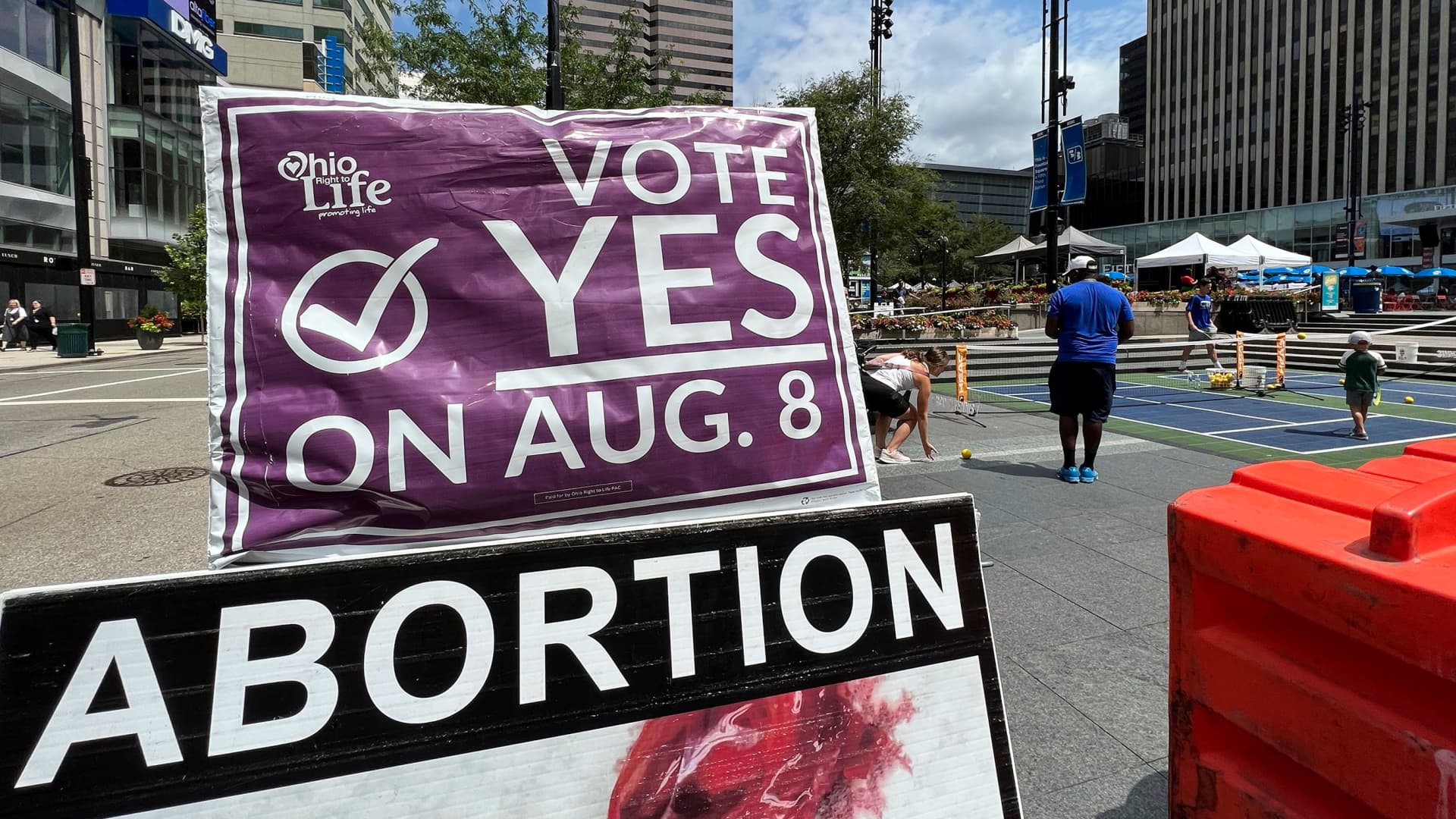A sign asking Ohioans to vote in support of Issue 1 sits above another sign advocating against abortion rights at an event hosted by Created Equal on Thursday, July 20, 2023, in Cincinnati, Ohio.
Patrick Orsagos | AP
Ohio voters on Tuesday resoundingly rejected a Republican-backed attempt to thwart an upcoming referendum that would enshrine abortion rights in the state constitution.
The failed GOP proposal, known as Issue 1, would have raised the minimum threshold of votes needed to amend the state constitution by popular referendum, from a simple majority up to 60% of ballots cast.
The failure of Issue 1 means a constitutional amendment to protect abortion rights will face a 50% threshold to pass when Ohioans vote again in November and therefore has a much better chance of succeeding.
The reproductive rights amendment would basically bar the state from interfering in women’s decisions on abortion, contraception, fertility treatment and miscarriage care.
A poll conducted by USA Today and Suffolk University in July found that 58% of Ohioans support the amendment to enshrine abortion rights in the state constitution.
Beyond Ohio, the vote Tuesday represents a red flag for Republican office holders nationwide, who had hoped that the voter backlash against the end of Roe would be confined to the 2022 ballot box. This vote in reliably Republican Ohio suggests the issue of abortion rights still draws voters to the polls in outsized numbers.
This is good news, however, for Ohio’s senior senator, Democrat Sherrod Brown, who faces a tough reelection battle next year in a state that Donald Trump won by 8 points in 2020
Ohioans United for Reproductive Rights, the coalition that drafted the amendment to protect abortion, is aiming to strike a decisive blow in November that would erase the state’s six week abortion ban and block any future effort to restrict reproductive rights in Ohio. The state’s six-week ban is currently on hold due to a court ruling.
The coalition is made up of the Ohio chapter of the American Civil Liberties Union, Planned Parenthood’s state advocacy organization, and numerous other state groups that support reproductive rights.
Ohioans United for Reproductive Rights filed the amendment protecting abortion rights with the state attorney general in February, and received the go-ahead to start collecting signatures in March.
Only then did Republicans in the state legislature move to raise the minimum threshold to pass constitutional changes.
The Ohio General Assembly approved Issue 1 in May and set the August 8 election date. Every Democrat in the state legislature and five Republicans in the state House opposed the effort.
Across the country, activists have increasingly taken the issue of abortion rights directly to voters through state referendums in the wake of the U.S. Supreme Court’s June 2022 decision to overturn Roe v. Wade, which protected the procedure as a constitutional right nationwide for nearly 50 years.
Kansas and Kentucky rejected anti-abortion amendments last year, while voters in California, Michigan and Vermont codified the procedure as a right under their state constitutions.
Republican donor Richard Uihlein, CEO of the packing supply company Uline, has bankrolled Protect Our Constitution, the main political action committee campaigning for Issue 1 in Ohio. Uihlein contributed $4 million to the group as of July.
Reproductive rights groups such as NARAL Pro-Choice slammed the attempt to raise the threshold for constitutional changes to 60% from a simple majority as a transparent “power play” designed to prevent voters from enshrining abortion rights in Ohio.
More than just abortion rights were at stake in Tuesday’s vote. The 60% threshold could have also threatened efforts to raise Ohio’s minimum wage to $15 through a referendum that is expected to be on the ballot in November of 2024.
If approved, the wage hike would go into effect in stages, and reach $15 in 2028.

